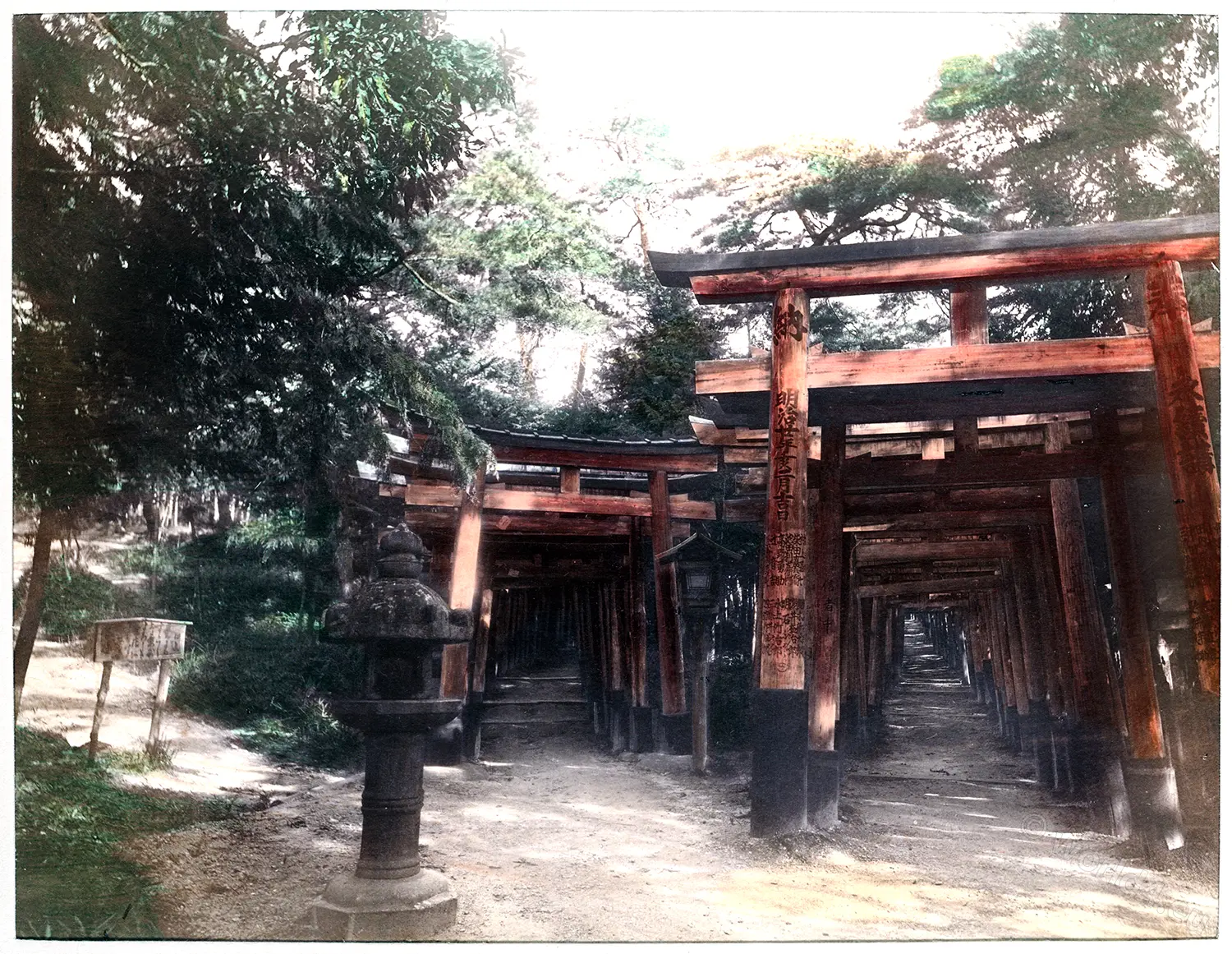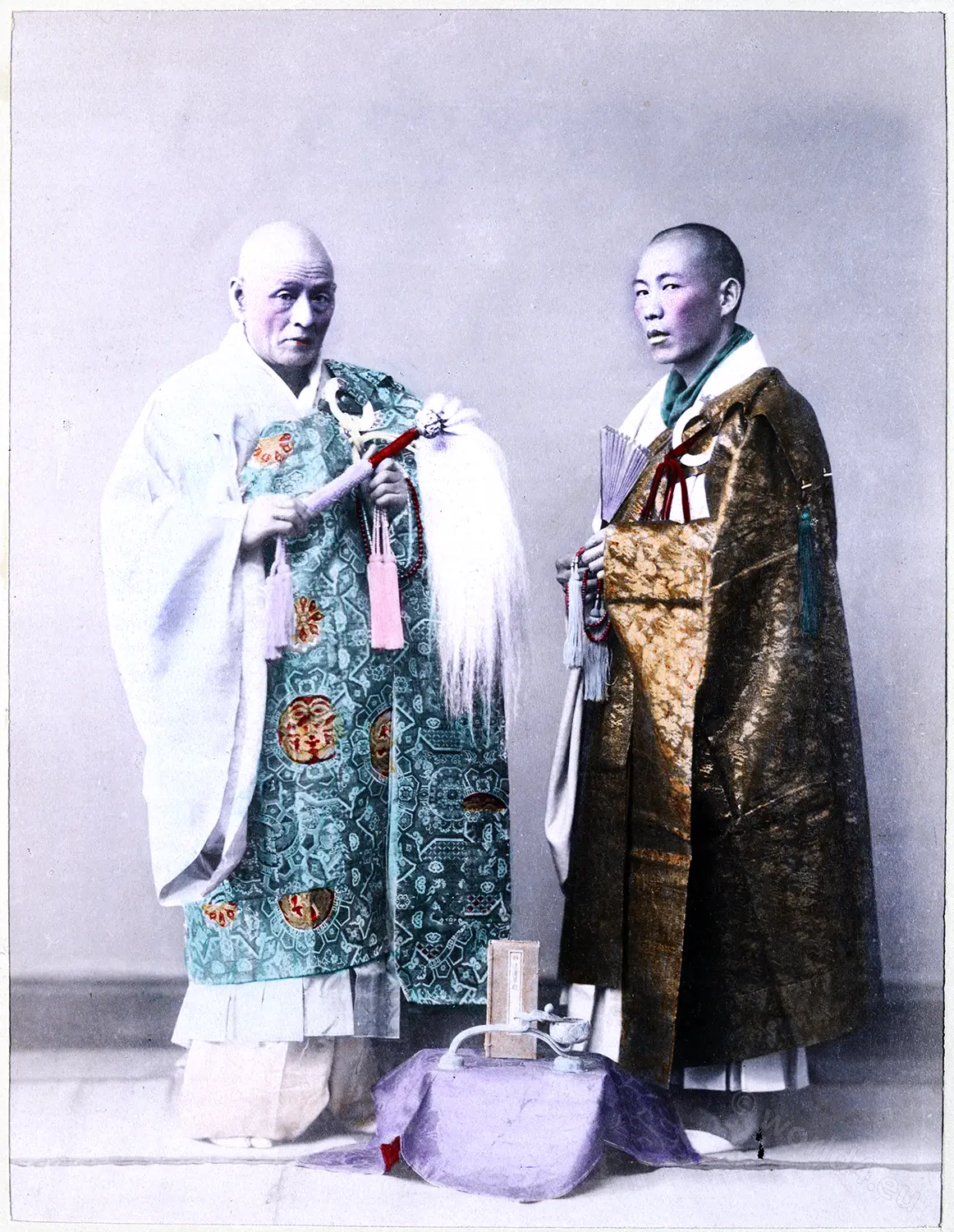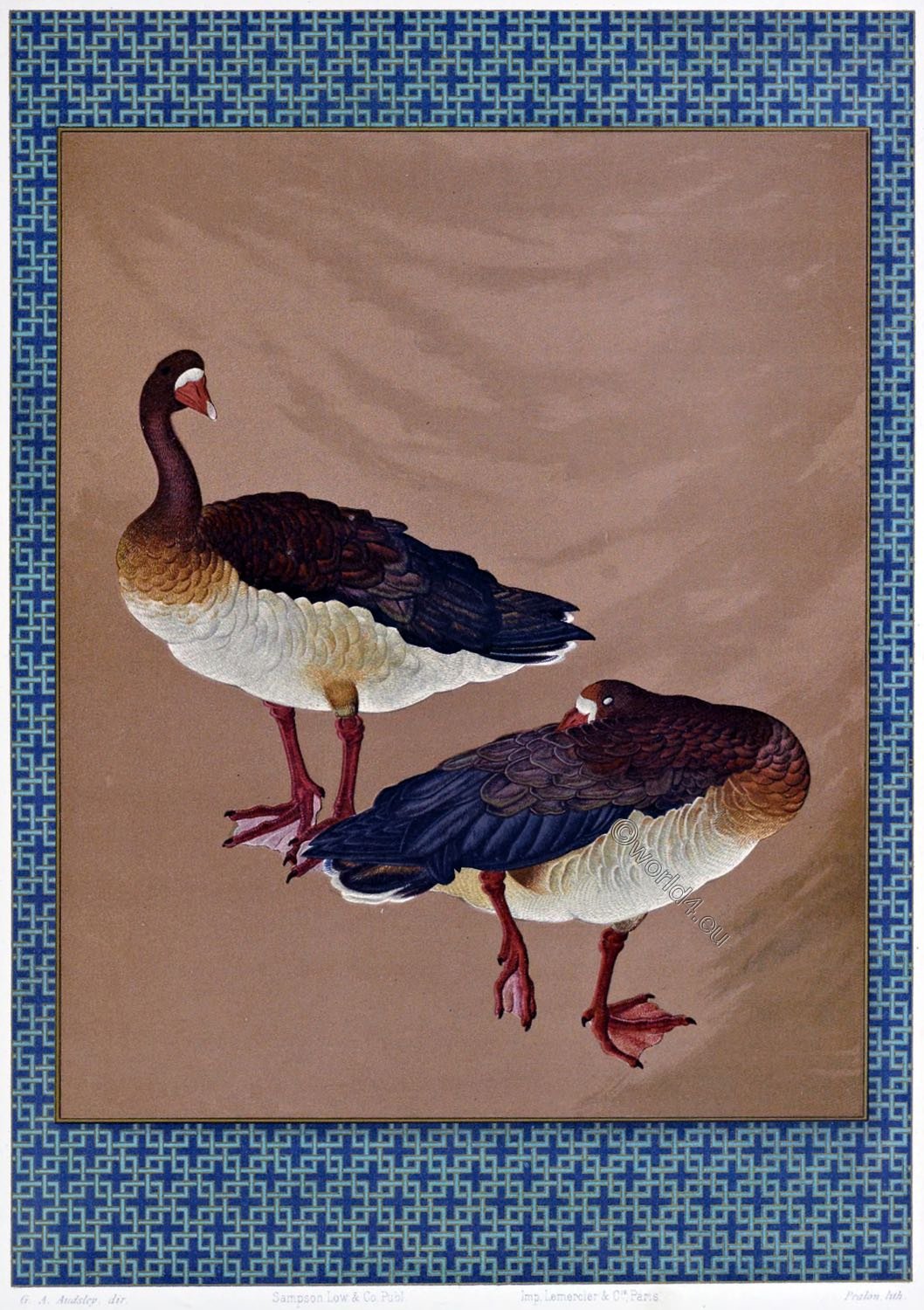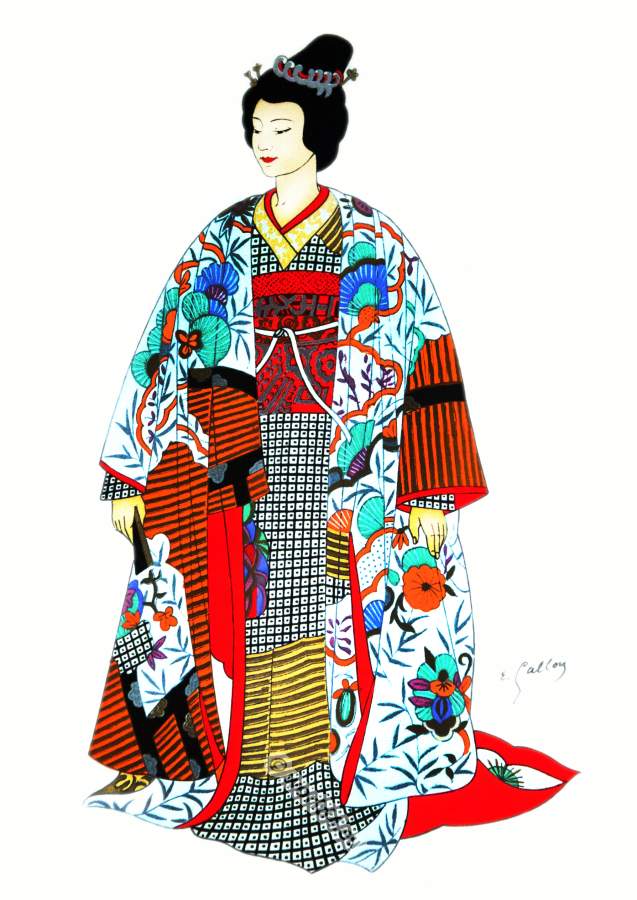AUTUMN FLOWERS.
CHRYSANTHEMUM
by Josiah Conder.
THE Chrysanthemum is the flower of Autumn, and the triumph of Japanese floricultural skill. Remarkable variety in form and colour of blossom is produced in the specimens cultivated in the gardens of the Court and nobility.
The Chrysanthemum flower, in its most exuberant form, loses its disc-like character, and presents a combination of long oval petals, partly extended, and partly curling inwards, exhibiting in contrast the different tints of face and back; whilst, in its most eccentric and artificial shape, it assumes the character of a confused mop of thread-like petals, more curious than beautiful. The florists aim at producing an extraordinary quantity of blossoms upon one stem, reaching often to the number of severalhundreds.
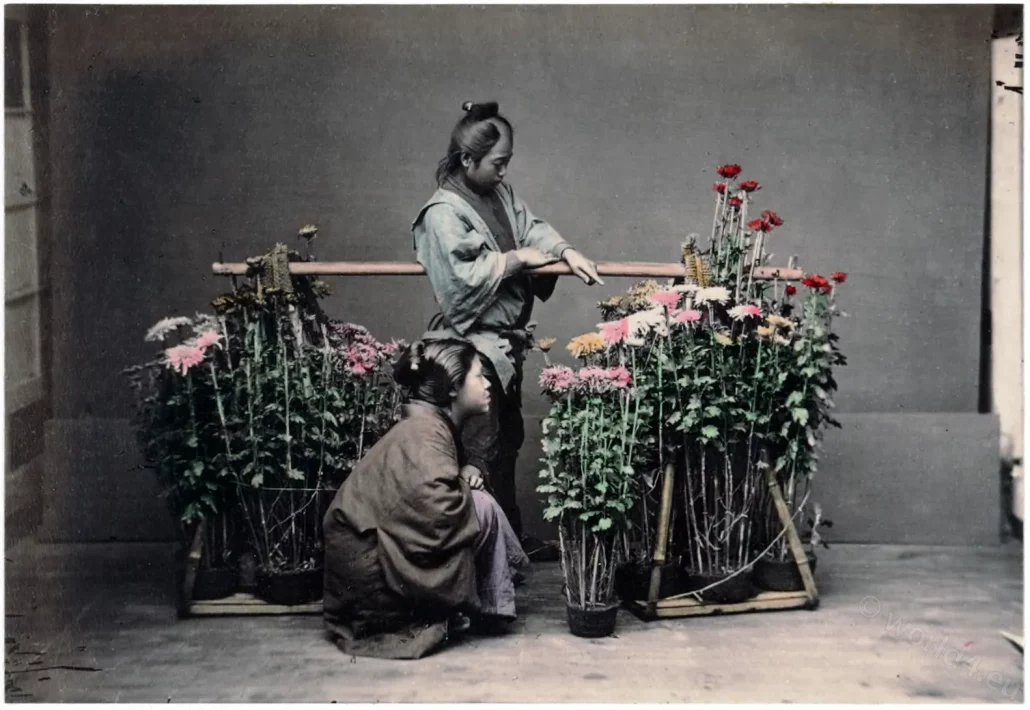
The varieties of the Japanese Kiku, or Chrysanthemum, are numerous, including not only those species classified as such by European botanists, but many kinds of Pyrethrum, Aster, and other generae.
It seems that the wild Chrysanthemum, of small flower, has always been indigenous to Japan, and held in considerable repute, from very early times, for medicinal purposes; in which connection early records state that large quantities of the yellow flower were yearly sent to the Imperial Court from the Southern provinces. The large cultivated flower, however, is said to have been imported from Corea or China and first planted at Hakata in the province of Chikuzen. At this time five colours were known, described as blue, yellow, red, white, and black, the term black probably referring to a dark purple colour. Originally these plants were reproduced by means of slips and cuttings, but now the seed is employed, which is said to give greater variety of blossom.
The Chrysanthemum is sometimes spoken of as the national flower of Japan, a rank really belonging to the Cherry blossom; and this misconception is probably owing to the former being used as one of the crests of the Imperial House. The flower has always been much honoured by the Court, and as early as the time of the Emperor Heizei, in the ninth century, garden parties were held in the Palace for the purpose of celebrating its blossoming time, just as, at the present day, a yearly Chrysanthemum show takes place in the Imperial grounds.
These ancient celebrations seem to have partaken of a truly pastoral character, the Courtiers wearing the plucked blossoms in their hair, drinking wine, and composing verses upon the beauties of the flowers.
The modern Chrysanthemum displays in the Palace gardens are more like our own flower-shows in the social conventionality of their arrangements; but the numerous variety, of every imaginable colour and profusion of shape, arranged in long open rustic sheds, forms a brilliant and imposing scene hardly rivalled by any flower-show in the world.
At the last display in the Imperial grounds at Akasaka there were a hundred and sixty varieties of blossom exhibited, each bearing a fancy name of its own. Some of these names are so poetically suggestive of the form or colour of the flowers that the enumeration of a few of them will not be out of place:-
- Chi-kiu-gi . . . Terrestrial Globe—-a large globular yellow flower.
- Gin-sekai . . . Silver World—-a flower of pure white colour.
- Usu-gasumi . . . Thin Mist—-a white flower.
- Tsuki-no-tomo . . . Companion of the Moon—-a white flower.
- Yu-hi-kage . . . Shadows of the Evening Sun—-a flower of dull red
- colour.
- Tama-sudare . . . The Blind of Gems—-a flower of orange red colour.
- Hatsu-yuki . . . The First Snow—-a pure white blossom.
- Hana-gatami . . . The Basket of Flowers—-a rich red flower.
- Kagari-bi . . . Beacon Light—-a red flower.
- Asa-hi-no-nami . . . Waves in the Morning Sun—-a reddish flower.
- Akeno-soya . . . Sky at Dawn—-a flower of cherry-blossom colour (pale pink).
- Skigarami . . . Garden Fence—-a flower the colour of the wistaria blossom (lavender colour).
- Asa-ne-gami . . . Dishevelled Hair (in morning sleep)-—a flower of tangled petals.
- Hoshi-dzuki-yo . . . Starlight Night—-a white flower.
- Hoshi-no-hikari . . . Star’s Brightness—-a pale bluish flower.
- Kimi-no-megumi . . . Blessings of Majesty—-a pale pink flower.
- Yuki-no-ashita . . . Snowy Morning—-a flower of pale pearly pink colour.
- Tsuki-no-kasa . . . Moon’s Halo-—a flower of orange red colour.
- Ogon-no-mskiki . . . Golden Brocade-—a flower of golden yellow colour.
- Shimo-no-lia . . . Leaves in Frost—-a white flower.
- Ogon-no-tsuyu . . . Golden Dew—-a bright yellow flower.
- Mangetsu . . . Full Moon-—a white flower.
- Gek-ka-no-nami . . . Moonlit Waves—-a flower of yellowish white colour.
- Haku-rio . . . White Dragon—-a white flower.
- Tsuyu-no-shita-zome . . . Dye of the Dew-—a flower of pale yellow colour.
There are said to be in Japan two hundred and sixty-nine colour varieties of the Chrysanthemum, of which sixty-three are yellow, eighty-seven white, thirty-two purple, thirty red, thirty-one pale pink, twelve russet, and fourteen of mixed colours.
A fancy prevails that in this flower the same tint is never exactly reproduced, and that in this it resembles the endless variety of the human countenance.
Blooming longer than most flowers, the Chrysanthemum has come to be associated with longevity. In the province of Kai, a hill, called the Chrysanthemum Mount, overhangs a river of clear water, into which the petals fall, and a belief exists that long life is assured by drinking the water of this stream.
A favourite motive of decoration, which may be seen in numerous conventional designs, is the Chrysanthemum blossom floating in running water.
A custom also survives of placing small blossoms or petals in
the cup during the wine-drinking which takes place during the festival of the ninth day of the ninth month.
The ordinary varieties of Chrysanthemum are to be seen in great abundance in the street fairs during the Autumn months. Dango-zaka, in Tokio, is the favourite popular resort, and here the flowers are trained into groups of figures and animals, representing historical subjects.
The Chrysanthemum is associated with the Crane, the Royal bird of Japan.
Mythological Japan.
KIKU. The Chrysanthemum
by Alexander F. Otto.
If it be an honour to merit the favour of royalty, then the noble Chrysanthemum is indeed satiated with honour for is it not the emperor’s flower, preferred above all others? Symbolising a gentle disposition, happiness, virtue and repose, and associated with longevity because of the extraordinary life of its bloom, it is naturally held in high esteem by all classes, particularly as the sixteen petalled variety forms the imperial crest of Japan.*)
We of the West can hardly conceive of what it means to assiduously cultivate over eight hundred varieties of a single flower, showing some two hundred and sixty nine shades of color — yet that is what Japanese floriculture has accomplished with the regal Chrysanthemum.
Dangozaka, quite near Tokio, is known far and wide for its Chrysanthemum gardens, containing countless groups of mythological figures, realistic representations of woven tapestries, and historic scenes, made entirely from living Chrysanthemums. Beautiful as are the Chrysanthemums of Dangozaka, those of Aoyama Palace, at one time the emperor’s residence, excel them in variety and pretentiousness.
The emperor’s birthday is celebrated among Aoyama’s regal blooms, a fitting place for royalty, where every shade of rose, crimson, yellow, pale lilac and purple, vie with one another in honouring their ruler. This joyous gala time is known as the Festival of Kiku, and one of its customs is that of placing Chrysanthemum petals in the cups during the wine drinking, insuring long life and happiness.
According to one of the mythical tales of the Japanese Chrysanthemum, there is a hill far away in Kai, known as the Chrysanthemum Mount, which overhangs a river of crystal clarity. Those who drink from the waters of this stream after the Chrysanthemum petals have fallen in it, receive the boon of long life; hence the theme of many an artistic scheme showing Chrysanthemums floating in running water.
Source:
- The floral art of Japan: being a second and revised edition of the flowers of Japan and the art of floral arrangement by Josiah Conder (1852-1920). Tokio: Kelly and Walsh, Ltd. 1899.
- Mythological Japan: the symbolisms of mythology in relation to Japanese art; by Alexander Francis Otto and Theodore S. Holbrook, with illustrations drawn in Japan, by native artists. Philadelphia: Drexel Biddle, 1902.
- JAPAN. Described and Illustrated by the Japanese. Written by Eminent Japanese Authorities and Scholars. Edited by Captain F. Brinkley (1841 – 1912) of Tokyo Japan. With an Essay on Japanese Art by Kakuzo Okakura (1860 – 1929) Director of the Imperial Art School at Tokyo Japan. 1897.
- In lotus-land Japan by Herbert George Ponting. London, Macmillan and co., limited, 1910.








